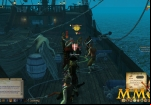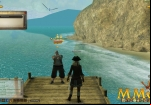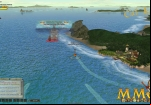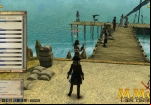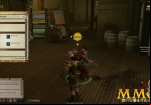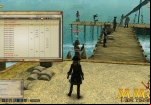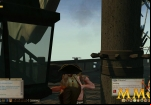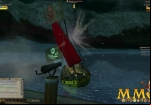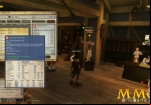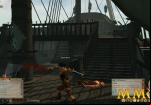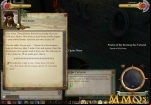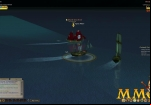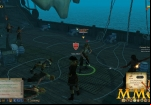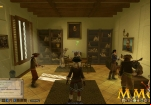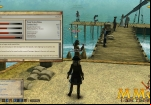Pirates of the Burning Sea
Pirates of the Burning Sea is an MMORPG set in the Caribbean during the 1700s that features swashbuckling, tactical ship combat, and a player-driven economy. Choose from four allied factions and take on your foes both at land and sea with a variety of class-specific abilities.
| Publisher: Vision Online Games Playerbase: Low Type: MMORPG PvP: Port Battles / Open Sea Combat Release Date: January 22, 2008 Pros: +Realistic naval combat. +Swashbuckling battles. +Four factions. +Varied content. Cons: -Steep learning curve. -Lacking character animations. -Repetitive gameplay. |
Pirates of the Burning Sea Overview
Pirates of the Burning Sea is a free-to-play MMORPG where players captain their own ship as a variety of classes that include: Freetraders, Naval Officers, and Cutthroats. Choose one of three factions that represent a European nation, or choose to become a pirate ready to plunder other ships on the open seas. Character avatars are highly customizable and can take part in the game's swashbuckling combat that pits fighting styles against each other on the decks of boarded ships and on land. The game's naval combat includes over 150+ historical ships that show realistic damage as they encounter enemies and offer full tactical control, giving players command over the ships' heading, speed, special abilities, and attacks. In line with the game's strong historical pirate theme each class acquires new ships in distinct ways: naval officers receive better ships as rewards for military commendations, pirates claim ships after defeating them in combat, and freetraders claim ship rewards with civilian pennants.
Pirates of the Burning Sea Key Features:
- Five Playable Classes – choose from five careers: Naval Officer, Privateer, Freetrader, Buccaneer, or Cutthroat.
- Four Player Factions – ally with one of the three European nations: England, , or Spain, or opt to be a pirate.
- Intense Ship Combat – take to the high seas and engage in tactical ship combat that includes over 150 different historical ships.
- Swashbuckling – participate in direct character combat using four fighting styles that include Florentine, Fencing, Dirty Fighting, and Brawling.
- PvP and PvE Modes – enter an allied port to begin a PvP Port Battle or stick to economy and trading in a game that s many different playstyles.
Pirates of the Burning Sea Screenshots
Pirates of the Burning Sea Featured Video
Pirates of the Burning Sea Review
By, Archibald Stryxs
Pirates of the Burning Sea is a long-running MMORPG set in the golden age of piracy, specifically the Caribbean of the 1720s. Originally developed by Flying Lab Software, the game launched on January 22, 2008 as a subscription-based title under the Sony Online Entertainment banner. At its debut, it offered a unique blend of high-seas adventure and swashbuckling action, standing out in an era dominated by fantasy MMOs. Development on the game actually began as early as 2002, and by the time of release the ambition was evident: players could captain historical ships, engage in tactical naval battles, and influence an evolving world economy and conflict between colonial powers.
Over the years, Pirates of the Burning Sea (PotBS) has seen significant changes in both its business model and stewardship. In late 2010, the game transitioned from a pure subscription model to a free-to-play (freemium) model, lowering the barrier for new players to experience its content. The first major expansion, Power & Prestige (released in 2010), expanded the conquest system and even allowed players to become governors of captured ports, highlighting the developers’ commitment to deepening the political metagame. After a couple of years, Flying Lab Software stepped away and a small group of the original team formed Portalus Games to keep the servers alive. Portalus ran PotBS from 2013 and introduced some tweaks and smaller content updates, but eventually announced closure plans around 2018. Fortunately, another company, Vision Online Games, took over operations in 2019 to continue ing the game. As of today, Pirates of the Burning Sea remains available as a free-to-play title. It has a niche but dedicated community, and even decades after launch it maintains a distinct appeal thanks to its rich historical setting and one-of-a-kind gameplay systems.
Gameplay Mechanics
Pirates of the Burning Sea offers a multifaceted gameplay experience that merges open-world exploration, strategic combat, and role-playing progression. Players begin by creating a character who serves as a ship captain in one of four factions: the colonial empires of Great Britain, , or Spain, or the independent Pirates (the Brethren of the Coast). This faction choice defines your overarching allegiance in the PvP war, as well as your starting region and ports. Beyond faction, you also choose a career (class) for your captain, which grants specific skills and playstyle focus. The game features five career options – Naval Officer, Privateer, Freetrader for the national factions, and Buccaneer or Cutthroat for pirate players. Naval Officers, for example, excel in large ship command and broadside combat, Privateers specialize in outmaneuvering enemies and skilled dueling, Freetraders focus on trade and economic bonuses, while Pirate careers emphasize guerilla tactics and boarding actions. This class system influences the abilities you’ll use in both ship combat and avatar combat, giving a sense of progression as you level up (the level cap is Rank 50) and unlock new skills and permissions to helm larger vessels.
Naval Combat
The naval combat is the centerpiece of PotBS’s gameplay and arguably its most celebrated feature. Battles at sea are instanced encounters (triggered when ships engage on the open sea map) that play out in real-time but at a deliberate, tactical pace. Captaining a ship isn’t about twitch reflexes, but rather about mastery of wind and water. You must manage your ship’s speed and heading relative to the wind to position effectively – turning for a perfect broadside or maintaining distance as needed. Combat involves firing various types of cannon shot from your broadsides: you can load round shot for hull damage, chain shot to shred enemy sails and cripple maneuverability, or grapeshot to clear the decks of enemy crew. The choice of ammunition and timing of volleys adds a layer of strategy; for instance, a common tactic is to use chain shot to slow a fleeing foe or soften a tough target by wrecking its sails before closing in. Ships also have crew which serve functions like reloading guns and repairing damage during battle, and crew losses (from enemy grapeshot or boarding actions) will hinder your ship’s performance. Each class career provides special abilities that can turn the tide – a Privateer might have a skill to temporarily boost speed or debuff an enemy’s accuracy, while a Naval Officer might call a defensive brace that mitigates incoming damage. The result is a naval combat system that feels like a thoughtful dance of cannons and canvas: it’s slower-paced than combat in many MMOs, but incredibly rewarding for players who enjoy outsmarting and outmaneuvering their opponents. Successful captains will often find themselves using terrain, wind, and clever ammo choices to defeat even superior ships. And for a grand finish, when an enemy vessel is sufficiently weakened, you can grapple and board it – transitioning to a swashbuckling fight with swords and pistols on the decks to capture the ship or simply eliminate the crew.
Swashbuckling (Land-Based Combat)
When not at the helm of a ship, players can engage in swashbuckling combat, which is the game’s form of avatar-based fighting. These encounters happen during specific mission instances (like tavern brawls, duels, or when boarding enemy ships) and in some on-land scenarios at ports. Swashbuckling is a third-person action combat system using melee weapons (and occasionally pistols) with a timed skill-based approach. There are four fighting styles to choose from: Fencing, Florentine, Dirty Fighting, and Brawling. Fencing focuses on elegant rapier strikes, Florentine uses a sword-and-dagger combo for balanced offense/defense, Dirty Fighting employs cutlass and pistol with underhanded tricks, and Brawling is all about brute force and fisticuffs. Each style has its own skill tree of special moves and combos, such as parries, heavy slashes, or dirty tricks like sand-in-the-eyes. While it’s fun to customize your pirate’s fighting style and appearance (the game offers a wealth of costume options for your avatar), the swashbuckling combat is generally considered a secondary feature to the naval warfare. It functions adequately – you can block, chain attacks, and use finishing moves – but the depth and thrill pales in comparison to the ship combat. Many missions will have you cutting through groups of NPC foes or engaging in a duel, and these encounters tend to be somewhat repetitive. Still, they break up the ship gameplay and add variety, giving captains a chance to get out from behind the wheel and cross swords with rivals up close and personal.
Ship Acquisition and Customization
Progression in Pirates of the Burning Sea is also tied strongly to ship acquisition and customization. The game features over 150 historical ships ranging from small swift cutters and sloops, to hefty frigates and massive ships-of-the-line. As you gain ranks, you become eligible to command larger classes of ships – nothing says “endgame” quite like finally captaining a first-rate warship bristling with cannons. Ships in PotBS are effectively the primary “gear” or equipment for your character, and they can be bought from players or earned through various means. Each faction/career has its own method of obtaining top ships: for example, Naval Officers might earn powerful navy vessels as mission rewards or through special commendations, Freetraders can acquire ships via crafting and commerce (or buy them on the player market), and Pirates often prefer to capture ships by boarding and taking them from NPC or player enemies. Uniquely, ships in this game are not permanent possessions if destroyed – they come with a limited number of durability points (lives). If your ship is sunk in battle, it loses one durability; lose all durability and that ship is gone for good, meaning you’ll need a replacement. This system creates a light risk of loss that makes PvP and high-level PvE more meaningful, somewhat akin to the ship loss mechanics in EVE Online (though PotBS softens the blow by allowing multiple “lives” per ship deed). To mitigate losses, players often keep a stock of backup ships or use insurance policies (in the freemium era, the cash shop sold insurance to protect ships from full loss).
Customizing your ship is an important aspect of gameplay. Beyond choosing the class of vessel, you can outfit it with various upgrades and ammunition. Ships have slots for equippable items like improved cannon type (for instance, swapping to naval cannons with better range or damage), hull armor, better sails or rigs for speed, and charm or tool items that boost certain attributes (like improved pumps to bail water faster when your hull is breached). You also load consumables such as repair kits for patching up sails or hull mid-battle, and different ammo types as mentioned earlier. This allows you to tailor a ship for different roles – perhaps you want a heavy brawler with reinforced hull and high-poundage cannon for fleet battles, or instead a nimble blockade runner with extra sails and cargo space for smuggling goods. The breadth of ships and outfitting options, combined with the player-driven crafting of these components, makes ship customization a satisfying pursuit for those who love tinkering with builds and maximizing performance on the high seas.
Economy and Trade System
One of the standout features of Pirates of the Burning Sea is its robust player-driven economy. In contrast to many MMOs where NPC vendors and loot drops dominate gear acquisition, PotBS’s economy is more akin to EVE Online’s industrial backbone or the trading of classic sandboxes. Nearly every ship, cannon, and consumable in the game can (and must) be crafted by players through a production chain. The game uses a system of economic structures (plots) that players can manage. Each can own a limited number of plots (for example, up to 10 per server) on which you can construct various facilities – such as logging camps, mines, farms, shipyards, cannon forges, sailmakers, etc. These structures operate on real-time production cycles: they accumulate labor hours (even while you’re offline, up to a 72-hour cap) which can be spent to produce resources and goods. For instance, you might build a lumber mill on a port that has timber resources, which produces wood planks; those planks can then feed into a shipyard to help construct a ship hull; meanwhile, iron ore from a mine can be smelted into ingots to create nails and cannons, and cotton from a plantation can be woven into sailcloth. High-end items like a fully-armed frigate require coordination of many such components – wood, iron, canvas, rope, tar, provisions, etc., often produced across multiple ports. It’s a deep crafting system that encourages specialization and player cooperation (or at least commerce) because one player is unlikely to personally own every type of production needed for a ship. Trading companies (the equivalent of guilds focusing on commerce) often divide tasks or trade resources internally to efficiently build the most valuable assets.
The trading aspect comes alive as players transport goods between ports and engage in commerce. The Caribbean is divided into numerous ports, each with specific local resources and production potential. This means certain materials might only be available (or cheapest) in one region and need to be hauled to another location where they are in demand. Trade routes form organically as merchants (especially players in the Freetrader career) move cargo for profit. Of course, this also introduces the risk vs reward element – carrying a load of valuable crafted cannons or a shipment of gold spices can paint a target on your back if you venture through dangerous waters where enemy privateers or pirates lurk. Smart traders will either hire escorts, travel during off-peak PvP times, or use ships with stealth and speed to avoid conflict. The economy ties directly into the conflict system as well: controlling certain ports can grant your faction access to critical resources, and during wartime, enemy ports may embargo your access to their markets. Savvy economic players can even influence the war by supplying allies with warships and munitions or by strategically denying resources to the enemy. Compared to many MMOs, the economic gameplay in PotBS is incredibly rich – similar in spirit to games like Uncharted Waters Online or EVE, it’s a paradise for crafters and traders. However, it’s also quite complex and has a learning curve; new players may need to consult guides or the community to fully grasp production efficiency. The effort is worth it: being able to launch a top-tier player-crafted ship or amass a fortune through trade is immensely satisfying and gives the game an open-ended sandbox quality beyond the structured quests and missions.
PvP and Faction Warfare
Pirates of the Burning Sea is at its heart a game of territorial conflict and PvP on both small and large scales. Upon ing one of the four factions, every player contributes (directly or indirectly) to their faction’s fortunes in the ongoing war for the Caribbean. The PvP system is centered around the concept of port contention and conquest. Here’s how it works: most ports across the map can be fought over by the nations (Britain, , Spain) and, to a degree, by the Pirate faction. A port controlled by one faction can be pushed into contention by the opposing forces through various activities. Players generate Unrest in an enemy port’s area by completing special PvE missions, sinking NPC ships near the port, and even by economic means (there are turn-in deliveries that can raise unrest). When enough unrest points are accumulated, the waters around that port turn into a PvP-enabled zone (often shown as a red circle on the map). Initially, this contested waters zone allows only certain PvP engagements – typically pirates and designated privateers can attack enemy shipping in this area, simulating the raiding that precedes a full assault. If players continue to pour on the pressure and unrest reaches higher thresholds, the PvP zone expands and eventually opens up fully, meaning any player from rival nations entering the vicinity can attack or be attacked. This escalating tension often leads to pitched ship battles in the open world as players skirmish for control and try to either raise or reduce unrest.
The culmination of this contention is the Port Battle. Once unrest has peaked for a sufficient duration, a scheduled port battle is declared for that location. These are large instanced PvP battles, typically allowing up to 24 players per side (though the exact number can vary) from the attacking and defending factions. The battle itself is a grand naval engagement – essentially the endgame PvP event that guilds (societies) and PvP enthusiasts live for. In a port battle, teams coordinate like fleets in a historical naval war: expect lines of battle, concentrated volleys, feints, and at times daring close-quarters maneuvers to decide who will claim the port. Strategy and teamwork are critical, as is the preparation; beforehand, factions will rally their best captains and ships, stockpile ammunition and repairs, and sometimes even assign roles (for example, some players might bring heavy ships to act as the line breakers while others use faster ships to flank or chase down stragglers). The winner of the port battle gains control of that port. If the attackers (say, ) win, the port switches to French control on the map; if defenders hold, it remains with its original owner. Capturing a port not only expands your nation’s territory but can confer advantages like access to its resources, gold from taxation, and a boost in overall war score.
The faction warfare in PotBS isn’t a perpetual tug-of-war with no end – it’s structured in cycles. Nations vie for dominance by capturing ports and scoring conquest points over a period. Eventually, a conquest cycle concludes (often after several weeks or when certain point thresholds are met), and one nation may be declared the victor of that round of war, sometimes resulting in a reset of some territorial control to restart the conflict fresh. This cyclical win-condition keeps the war dynamic; there are periods of intense conflict and then a brief lull as things reset and players prepare for the next round of fighting. Notably, the Pirate faction plays by slightly different rules: rather than holding territory long-term and winning via conquest points, pirates thrive on sowing chaos. They can attack any nation’s ships in contested waters and can even flip ports to temporarily become "Pirate Havens", denying the economic benefits to all nations until the haven status expires or is cleared. Pirates essentially function as the wildcard faction – they can’t win the map in the same way a nation can, but they can disrupt the balance and profit from constant warfare. Some players love the pirate life for its free-for-all nature (and the ability to capture enemy ships for their own use), but it’s a challenging path since pirates are often outnumbered and lack safe harbors in many regions.
Outside of port battles, PvP also occurs in more spontaneous forms. Whenever you sail through a contested area or near an enemy player in the open sea, there is a risk of being pulled into an impromptu ship battle instance if one side initiates combat. This means vigilant players can form small PvP hunting parties to intercept traders or ambush lone warships, leading to skirmishes that are not scheduled but rather emergent from the open-world travel. The stakes in PvP are high because defeat might mean losing your ship’s durability (or the ship entirely), and victors can loot some of the sinking ship’s cargo or other rewards. This encourages players to think carefully about when to risk their best vessel or when to flee and live to fight another day. For those who prefer consent-based PvP, the game also s duels and skirmish matches, but the real meat is in the open-sea fights and port wars. Overall, the PvP and faction warfare of Pirates of the Burning Sea offer a compelling blend of strategy, risk, and reward. It successfully makes you feel like a cog in a larger naval war effort – whether you’re a national navy officer fighting for king and country or a rascally pirate out for personal gain, your actions impact the political landscape of the game world.
Graphics and Sound
Given its 2008 release, Pirates of the Burning Sea’s graphics are understandably dated by modern standards, yet there are aspects of its presentation that still hold charm. The game went for a realistic art style aimed at depicting the Age of Sail with a degree of authenticity. The ship models and water effects were particularly lauded at launch – ships are rendered with attention to detail, from the number of guns on the decks to the way sails billow in the wind and take visible damage (tattered sails, fire and smoke during battle, etc.). Even today, watching two frigates exchange broadsides at sunset, with cannon fire lighting up the sky, can be quite spectacular. The water and weather effects (like storms or calm seas) add atmosphere to sea journeys. However, the trade-off of an older engine is evident in the character models and animations. Player avatars and NPCs have somewhat stiff animations and less detailed textures compared to contemporary MMOs; for example, the walking/running animations and swordfight moves feel a bit mechanical. The environments in ports – towns, jungles, forts – are serviceable but not very dynamic. Don’t expect cutting-edge lighting or the lush detail of newer games; PotBS looks like a product of the late 2000s, which is to say it’s comparable to something like early EverQuest II era visuals but with a more realistic tone. It’s clear that the visual emphasis (and development resources) went into the ships and ocean, which makes sense given how much time you spend at sea.
On the plus side, the game’s interface is fairly clean and functional, albeit utilitarian. There are numerous windows for inventory, ship management, economy, etc., which can clutter the screen until you get used to organizing them. Modern players might find the UI clunky, but it’s not overly convoluted once you learn where things are.
In of sound and music, Pirates of the Burning Sea delivers a solid experience. The soundtrack features an original score with swashbuckling orchestral pieces that suit the period – jaunty tavern tunes when you’re in port, and tense battle music that ramps up when cannons fire. It’s an atmospheric soundtrack that complements the gameplay without overshadowing it. Sound effects are a highlight: the thunderous boom of your broadsides, the crack of a mast breaking, the roar of fire as a ship’s magazine explodes – these audio cues make battles more visceral. In port, you’ll hear ambient sounds like creaking wood, seagulls, and crowd chatter, which help set the scene. There isn’t extensive voice acting; mission text is mostly delivered via written dialogue, a common practice in 2008 MMOs. Thus, the audio reliance is on music and effects rather than spoken NPC interaction. All in all, while the graphics won’t wow anyone in 2025 and the character aspect appears aged, the game’s visuals are cohesive and functional for what they aim to present, and the sound design effectively immerses you in a seafaring adventure. Players who prioritize gameplay depth over cutting-edge graphics will find PotBS perfectly acceptable in presentation, especially if they have a soft spot for classic MMORPG aesthetics.
Community and Longevity
Pirates of the Burning Sea has had an interesting journey when it comes to its community and lifespan. During its initial launch in 2008, the game attracted a mix of history buffs, PvP enthusiasts, and curious MMO players looking for something different than elves and orcs. Early reviews often noted that the game had a steep learning curve and very niche appeal, which meant PotBS never achieved mass-market popularity on the scale of giants like World of Warcraft. Within the first year, server merges were conducted to bolster player populations – a clear sign that while the game had dedicated players, the overall numbers were modest. This was a double-edged sword: on one hand, the smaller community size meant that players often got to know each other, rivalries and alliances became familiar, and there was a strong sense of community identity within each server. On the other hand, finding a healthy population for matchmaking port battles or a bustling player economy required condensing everyone onto fewer servers. By 2010, the playerbase was dedicated but small enough that the switch to a free-to-play model aimed to attract newcomers and bring back lapsed captains. This F2P transition did make it easier for curious players to hop in, but by that point PotBS was competing with a wave of newer F2P titles and had to carve out its niche as a somewhat older title.
Through the Portalus Games era (2013-2015) and into Vision Online’s stewardship, the community that stuck with PotBS can best be described as tight-knit and ionate. Many of the current players are veterans who have been sailing the in-game seas for years. New players do still trickle in – often fans of naval history or those who discovered the game via word-of-mouth and want to try a different style of MMO. The community is generally welcoming to newcomers, because they are eager to grow their ranks and on knowledge to keep the game alive. You’ll find that the remaining playerbase often congregates on the official forums or community Discords to organize events like PvP nights, economic summits, or reenactment-style scenarios for fun. It’s the kind of MMO where ing a society (guild) is highly recommended, as it will drastically improve your experience – having allies to teach you the ropes of ship combat or to collaborate with in crafting makes the complex systems more manageable. The flipside is that if you try to play completely solo, the world can feel empty at times, especially during off-peak hours. Given the age of the game and the limited marketing in recent years, you won’t see hundreds of players swarming a port like you would in newer MMOs’ cities. The peak activity is usually around scheduled port battles or community events, where the seas suddenly feel alive with privateer fleets and pirate hunters.
In of longevity, it’s impressive that Pirates of the Burning Sea is still around at all. It has survived the test of time due to its uniqueness – there simply aren’t many games that scratch the same itch of 18th-century naval warfare in an MMO format. The developers and community have shown resilience: after the near-shutdown in 2012, the revival under Portalus and then Vision Online’s takeover in 2019 demonstrate a strong will to keep the captain’s wheel turning. That said, active development of new content has been limited for many years. Major updates or expansions are a thing of the past; the current stewards mainly focus on maintenance, balance tweaks, and keeping the servers running. There was news of an initiative to bring PotBS to Steam (as of 2023) to increase visibility, which indicates the team’s hope to attract a new generation of players or lapsed veterans through that platform. If successful, such a move could slightly bolster the population and give the game a small renaissance. Regardless, the game’s longevity comes from its community-driven content – the wars, the economy, the role-play – rather than constant developer-added features. In essence, Pirates of the Burning Sea has become an anachronistic gem in the MMO sphere: it’s old and a bit rough around the edges, but those who love it are keeping its spirit alive, and it offers an experience you can’t quite get anywhere else.
Final Verdict - Good
Pirates of the Burning Sea embraces its niche boldly, offering rewarding naval combat, a deep economic system, and engaging nation-based warfare set in an authentic Caribbean backdrop. Tactical naval encounters and player-driven trade provide thrills rarely matched in modern MMOs. However, new players face outdated visuals, complex mechanics, and a steep learning curve, while on-foot combat remains basic and repetitive. The game's modest playerbase can make the world feel sparse, emphasizing the importance of community involvement over NPC-driven activities. Ultimately, PotBS remains a uniquely satisfying experience for strategic sandbox enthusiasts who overlook its aging presentation, while players seeking polished graphics or vibrant populations may find it lacking.
Pirates of the Burning Sea Videos4
Pirates of the Burning Sea Online Links
Pirates of the Burning Sea Official Site
Pirates of the Burning Sea Official Forums
Pirates of the Burning Sea Wiki (Info / Guides)
Pirates of the Burning Sea System Requirements
Minimum Requirements:
Operating System: Windows XP / Vista
U: Pentium IV 1.5 GHz
Video Card: NVIDIA GeForce FX 5700 or equivalent
RAM: 512 MB
Hard Disk Space: 4 GB
Recommended Requirements:
Operating System: Windows XP / Vista
U: Core Duo 2.0 GHz or better
Video Card: NVIDIA GeForce 6600 or better
RAM: 1024 MB
Hard Disk Space: 4 GB
Pirates of the Burning Sea Music & Soundtrack
Coming Soon...
Pirates of the Burning Sea Additional Information
Developer: Flying Lab Software, Portalus Games
Publisher: Portalus Games, Gamearena, Sony Online Entertainment
Open Beta Date: December 14, 2005 to January 1, 2008
Pre-Release Date: January 07, 2008
Release Date: January 22, 2008
Development History / Background:
Pirates of the Burning Sea was developed by Flying Lab Software and published initially by Sony Online Entertainment. The game's development began in 2002; its developers realized the size and potential of the game and nearly doubled their staff, putting other projects on hold by December 14, 2005 when the game's open beta began. Open beta ran until January 01, 2008, and the game's pre-release started shortly thereafter on January 07, 2008. Pirates of the Burning Sea was initially subscription-based. Its early adopters gained pre-release access before the retail release date of January 22, 2008. By April, 2008, the developers offered one-time server transfers to reduce the amount of servers available and increase individual populations, closing seven servers overall by November, 2008. On March 05, 2010, the servers were further reduced, with only the servers Roberts and Antigua remaining. The game changed its subscription model shortly thereafter, moving to a multi-tiered freemium model on November 22, 2010.
In December 2012, Sony Online Entertainment announced that Pirates of the Burning Sea was being shut down, which led a small group of the original developers from Flying Lab Software to pick the game up and host it themselves under a newly formed studio, Portalus Games. Portalus ran the game from February 2013 to 2015 but eventually shut down. The game is still available as a free to play title by Vision Online Games





